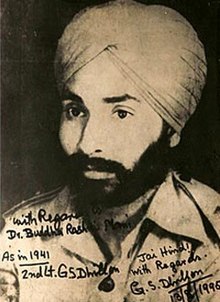
Summary
Gurbaksh Singh Dhillon (18 March 1914 – 6 February 2006) was an officer of the Indian National Army (INA). He faced charges of "waging war against His Majesty the King Emperor" due to his pivotal role in the Indian independence movement. For his contributions, he was awarded the Padma Bhushan, the third-highest civilian honour of the Republic of India.

Early life edit
Born into a Dhillon Jat family in Algon village, Punjab, on 18 March 1914, Dhillon was the fourth child of Sardar Takhar Singh. His diverse educational background exposed him to multiple religions, fostering his secular beliefs. An active member of the Boy Scout Association, Dhillon was proficient in several languages, including Persian, Urdu, Hindi, Punjabi and English.
Military career edit
Army enlistment edit
Dhillon's enlistment in the Indian Army came upon J.F.L. Taylor's recommendation. Joining as a sepoy on 29 May 1933, he was part of the Training Battalion of the 10/14th Punjab Regiment. By March 1934, he completed his training. Recognizing his potential, he was selected for advanced training at Kitchner College in Nowgong, a precursor to his admission at the Indian Military Academy (IMA) in Dehradun. However, the outbreak of World War II shortened his tenure at the IMA, leading to his graduation in March 1940. He then joined the 1st Battalion of the 14th Punjab Regiment, colloquially known as "Sher Dil Paltan", in Lahore.
Overseas deployment edit
Anticipating overseas deployment, Dhillon's battalion departed from Secunderabad on 3 March 1941, heading to Penang Island and later to Ipoh, north of Kuala Lumpur in British Malaya. They were subsequently stationed at Sungai Pattani in South Kedah, integrating into the 5th Indian Infantry Brigade.
World War II edit
Following the attack on Pearl Harbor on 7 December 1941, the U.S. declared war on Japan. Concurrently, Japanese forces targeted the Royal Air Force bases in Sungei, Alor Star, and Kota Bharu. By 11 December, Dhillon's regiment was engaged in the intense Battle of Changlun, which ended in defeat. The subsequent days saw the fall of Alor Star and other strategic locations to the Japanese.
Indian National Army edit
Formation and development edit
At Farrer Park, Mohan Singh initiated the formation of the INA. Dhillon, inspired by this vision, pledged his allegiance to the INA on 17 February 1942. As the INA underwent restructuring, Dhillon assumed various roles, including Deputy Quartermaster General, overseeing logistics and equipment.
The 5th Guerrilla Regiment edit
By December 1943, Dhillon was appointed deputy to Major J.W. Rodrigues, who founded the 5th Guerrilla Regiment at Bidadari in Singapore. Dhillon was instrumental in the regiment's formation, training, and welfare.
Deployment to Burma edit
Dhillon's journey through Burma was marked by strategic movements, battles and retreats. The INA's initial successes were overshadowed by subsequent challenges, especially near Nyaungu. By early April 1945, the INA faced significant setbacks, leading to their retreat through the dense forests of the Pegu Yomas.
Surrender and aftermath edit
The INA's surrender to British forces on 17 May 1945 marked the end of their military campaign. Dhillon, along with other INA leaders, was detained and later tried. Their trial, known as the Indian National Army trials, began on 5 November 1945 and concluded on 31 December. Despite their convictions, the sentences were remitted due to the prevailing political climate.
Recognition edit
Dhillon's contributions to India's freedom struggle were recognized with the Padma Bhushan award in 1998. Additionally, the Indian Postal Department issued a commemorative stamp in his honor in 1997.[1]
Personal life edit
Dhillon married Basant Kaur in 1928. They had a daughter and two sons. Dhillon spent his later years in "Dhillon’s Den" in Hatod, Shivpuri district, Madhya Pradesh, passing away on 6 February 2006.
References edit
- ^ Mahotsav, Amrit. "Colonel Gurbaksh Singh Dhillon". Azadi Ka Amrit Mahotsav, Ministry of Culture, Government of India.
- Singh, Harkirat (2003). The INA Trial and the Raj. Atlantic Publishers & Distributors. p. 54. ISBN 978-81-269-0316-0.
- Bayly, Christopher; Harper, Tim (2008). Forgotten Wars: The End of Britain's Asian Empire. Penguin Books Limited. p. 262. ISBN 978-0-14-190980-6.
- Mukherjee, Mithi (2019). "The "Right to Wage War" against Empire: Anticolonialism and the Challenge to International Law in the Indian National Army Trial of 1945". Law and Social Inquiry. 44 (2): 420–443. doi:10.1017/lsi.2019.12. S2CID 191697854.
- Stephen P. Cohen "Subhas Chandra Bose and the Indian National Army" Pacific Affairs Vol. 36, No. 4 (Winter, 1963) pp 411–429
- Batabyal, R. (2005). Communalism in Bengal: From Famine To Noakhali, 1943-47 (in Indonesian). SAGE Publications. p. 191. ISBN 978-81-321-0205-2. Retrieved 4 June 2023.
- Green, L.C. (1948). "The Indian National Army Trials". The Modern Law Review. 11 (4): 47–69. doi:10.1111/j.1468-2230.1948.tb00071.x. JSTOR 1090088.
- Sharma, Ram Rakesh (1949): Azad Hind Fouj
- Nirad C. Chaudhuri "Subhas Chandra Bose-His Legacy and Legend" Pacific Affairs Vol. 26, No. 4 (December 1953), pp. 349–350
- "Historical Journey of the Indian National Army". National Archive of Singapore.
- Lebra, Joyce C., Jungle Alliance: Japan and the Indian National Army, Singapore, Asia Pacific Library
- Borra R. Subhash Chandra Bose. Journal of Historical Review, 3, no. 4 (Winter 1982), pp. 407–439
- "Hitler's Secret Indian Army Last Section: "Mutinies"". Retrieved 8 August 2006.
- ""Many I.N.A. men already executed, Lucknow"". The Hindustan Times. 2 November 1945. Archived from the original on 2007-08-09. Retrieved 11 August 2006.
```


